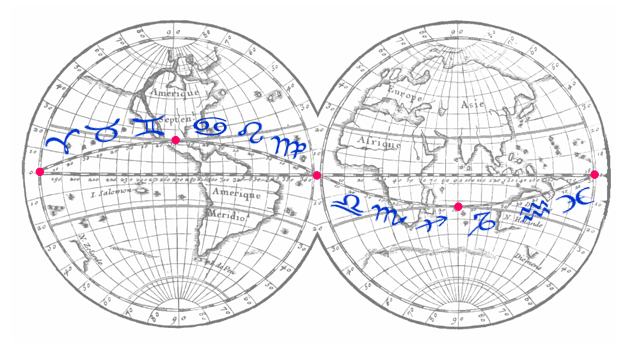The dilemma
When the South hemisphere question first came to my mind, I was puzzled by the fact classical calculations were not reflecting the season's inversion. In the mean time, if we opted for inversing the signs for the Southern hemisphere to make them match with the seasons, we then came with another problem: people born close to each other but in opposite hemispheres (1° North and 1° South of the equator) would end up with opposite Sun signs and this does not make sense at all. The best solution was then to keep the status quo, and not inverse anything. But, when in 1997, I read Max Duval's article (1) suggesting to inverse the signs, not on the equator, but on the ecliptic, I got hooked by the idea as it was starting to make more sense!
What is the classic Tropical zodiac ?
As seen from inclined Earth, the Tropical zodiac is directly associated to the 4 seasons, that are separated by the 4 cardinal points. See Fig. 1 above.
If the earth was not tilted on its axis, there would be no seasons, and we would only view the planets in the Sideral zodiac in the proximity of the equator. If we had to make charts for such an environment, we would probably work with the celestial latitude variations of the planets. Declination occurs as the direct consequence of earth's decline. It defines the tropical zodiac that links us to the seasons and affects the way we experience the sky in our daily lives: the earth's obliquity combined with our place on earth defines the declination and altitude paths the planets take in our skies.
Declination motions relate to the 12 tropical signs. Each declination degree decides on where a planet rises (East, N-E or S-E), where it reaches the MC (South -seen from up-north-, or North -seen from down-south-, but with huge altitude variations between Solstice points) and where it sets (West, N-W or S-W).
Each latitude or place on Earth has its particular zodiac, that relates to the typical zodiac we know, or its symmetrical image for the Southern hemisphere. The same applies to all planets that, in relation to their declination cycle, are deeply attached to the tropical zodiac (except Pluto).
The Tropical zodiac works well for astrologers thanks to the ecliptic's stability: seen from the declination point of view it's pattern is fixed and regular. Indeed, when the Sun crosses the equator, at 0° N/S, it points at all equinoxes, 0° Aries or Libra. Fig. 2:
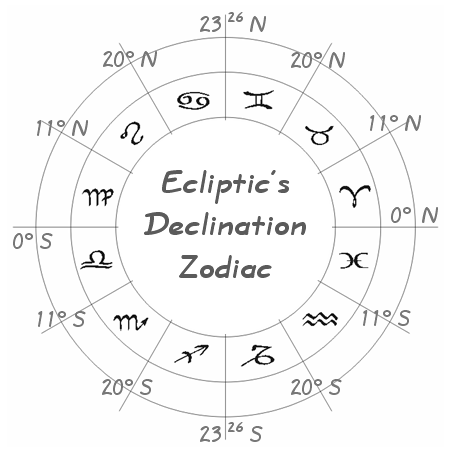
Bearing in mind that this declination factor does not apply to the Sideral zodiac, this astronomical consideration reminds us that the annual cycle of the 4 seasons reverses in the Southern hemisphere.
Max Duval's inversion theory
The great idea of French astrologer Max Duval was to inverse the signs not on the equator, but on the ecliptic. This means planet Earth can be sliced in three separate zones:
a/ All places North of the Tropic of Cancer -23°26'N- follow the typical Northern zodiac This is the natural tropical declination zodiac. Inspired since 1985 by the works of Jean-Pierre Nicola and Dane Rudhyar, I will develop ‘ The hidden meanings of the declination zodiac' at ISAR 2005 Biennial Conference (2), and at the European AAGB Conference (3).
b/ All places South of the Tropic of Capricorn -23°26'S- follow an inversion to Southern zodiac As it is widely admitted that for any date, the Sun sign is the same for any place on earth, I expect the software to do accordingly… But because I understand that sign symbolism is derived from declination motion, I have no choice but to follow the sign inversion (phase) for all places situated below the tropic of Capricorn. How to apply this, practically?
Example 1. A chart cast for 1 st January after sunrise and giving a 12 th House Sun in Capricorn in the Northern hemisphere, will swap to a 12 th House Sun in Southern Cancer/Phase. All planets stay in the same houses, it's only the sign/phase that swaps with its opposite symbol.
In all case, we must swap the Nodes (seen from the South, the Dragon's Head becomes the Tail): a NN in the 10th House should read as SN in the 10th.
Example 2. Author Germaine Greer born on 29 Jan 1939, 6:am AEST, Melbourne (37S49-144E58) (4). First, we print the normal chart with any good software like Solar Fire or Argus . Then with a pencil, we simply cross the signs and replace them with their opposite (here outside in grey). Fig.3 ->
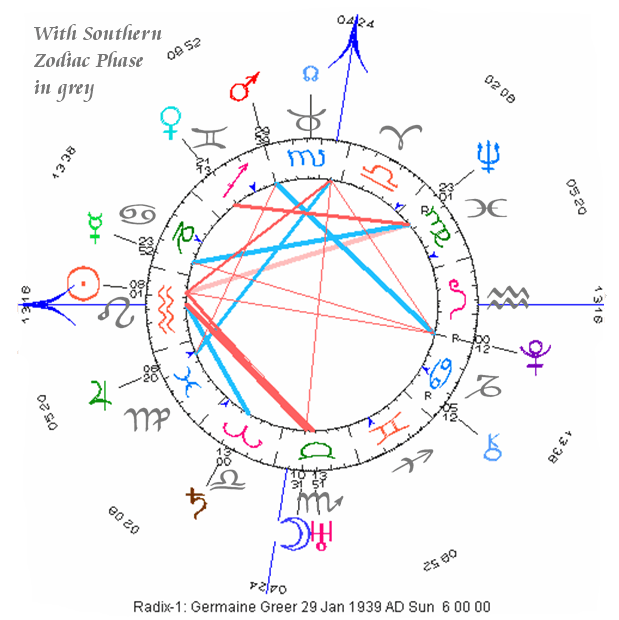
One of the changes is her Northern Aquarius Sun and ASC becoming Southern Leo . As pointed by Max Duval, wouldn't it be awkward to consider the Sun in detriment for a birth that occurred in the hottest season? Radiant Leo, G.G. kept all her shine, when regularly on BBC2 NewsNight, in the early 2000's.
The other change is her Northern Taurus Moon-Uranus that becomes Southern Scorpio . The Moon-Uranus conjunction in Scorpio was a major configuration to inspire the author of ‘The Female Eunuch'.
I understand that it's even more complex to graph the reality of Southern hemisphere charts (south of the Tropic of Capricorn): like in Melbourne (Australia), where facing a North Midheaven, the Sun rises there from the right and sets on left side of the horizon (opposite situation that of North of Tropic of Cancer where when facing a South Midheaven, the Sun rises from the left and sets on the right). To view it accordingly, we could still make a horizontal flip and view it though a window or a light bulb, but it's pretty disorienting for any astrologer used to draw Ascendants on the left side of charts.
I noticed that the Local Space chart, watching the zodiac facing North, was not bad in representing the local situation. Fig. 4 ->
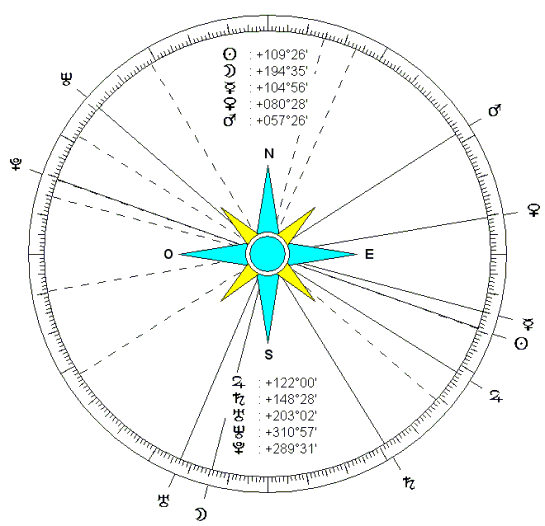
c/ The inter-tropical region, around the equator and in between the tropics, alters between the Northern and the Southern zodiac.
The equatorial region is a tricky one as it daily alters between Northern and Southern zodiac phases. Astro mapping helps to figure out if a place of birth is North or South of the ecliptic.
Fig. 5 shows the astro mapping for Germaine Greer's time of birth. The map is also valid for all people born the same day and at the same time (28/1/1939, 20h GMT), and therefore can serve as a tool to illustrate the idea.
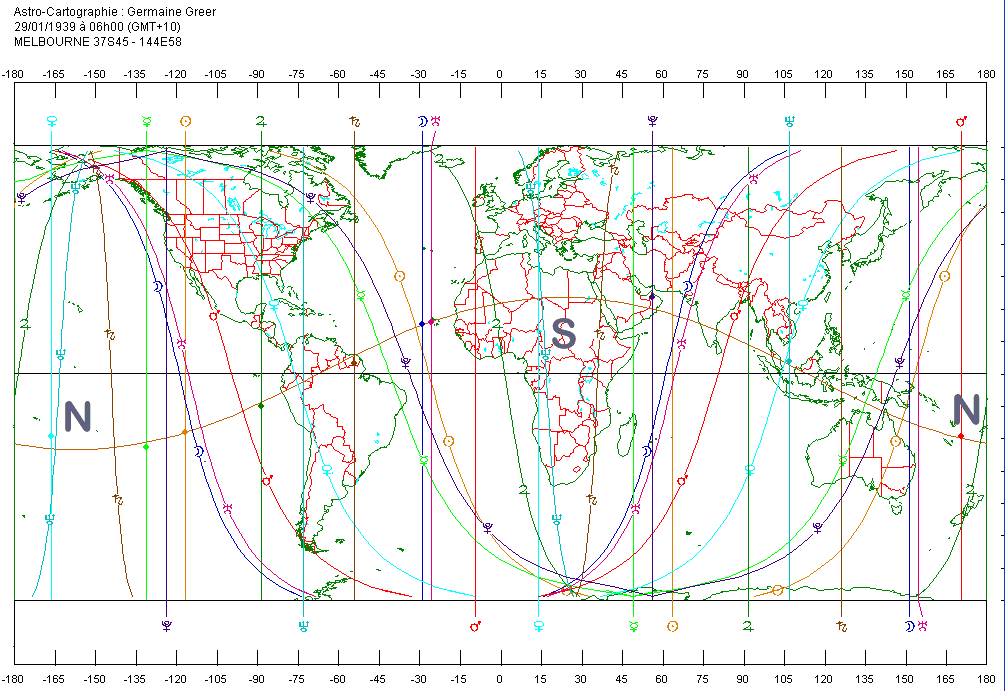
I found a mental calculation shortcut :
- If the MC falls between Sagittarius/Capricorn, then the place of birth is probably above the ecliptic, and so the northern zodiac applies;
- But if the MC falls between Gemini-Cancer, the place of birth will tend to be below the ecliptic, and so inversion occurs.
- For other MCs, the easiest is to check with astro-mapping, to view whether the place of birth is above or below the ecliptic.
The equatorial region is indeed pretty mixed and non-differentiated, compared to the regions well distant from it, where most of us live, and where the zodiac of 12 signs we know and most civilizations were born. This inter-tropical region is the best situated region to feel these common qualities between opposite signs, as the differentiation described above is less noticeable when seen from that region. Nevertheless, the six zodiacal axis are well represented.
1/ Aries and Libra are both open to relationship and they excel at defending individual freedoms. Both impulsive and innovative, they are warriors, rapid in their reactions.
2/ Taurus and Scorpio are both kind of possessive, and share abilities to build or destroy. Being at midpoint between solstice and equinoxes, they have the sense of proportions and are sensitive to games of power.
3/ Gemini and Sagittarius are both curious to explore life's diversities and are sensitive to the purpose of education (elevation). They both love to be on the move, need space to expand, visit the extremes and play with concepts and ideas.
4/ Cancer and Capricorn: while sharing interest for the origins of the transmission of life's genes from one generation to the other, both relate to homes or old stones and excel with protectionism instincts (and the building of walls). They both know about withdrawal, or falling back to a previous position (like Cancer falling back to Gemini declinations, or Capricorn falling back to Sagittarius declinations).
5/ Leo and Aquarius share skills in education, decoration and at organizing the socio-cultural fields. As the other Fixed signs, they share the sense of proportions, and understand the principles of power..
6/ Virgo and Pisces are the most reserved and caring types, so caring
that they can hesitate long before making decisions. They both look
to reach the equatorial balance, or reconciliation between opposites.
Virgo is more known to looks after the book balance (accounts), while
Pisces works also with the hidden lights, allowing for compassion, forgiving
or praying. This
universality of the 12 signs and the 6 axis sits within ourselves like
a celestial DNA. Even if we don't have all signs occupied by planets
at birth, we continue to experience them through every day's "life"
transits. Like, from any location on earth, the June Sun takes an apparent
different path in the sky than the Sun in December. Fig. 6:
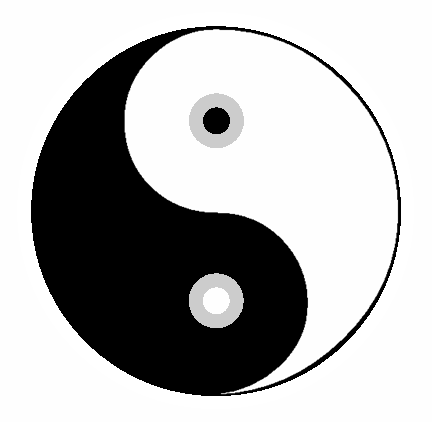
By the way, any other inversions for the South Hemisphere?
1/ When standing up , we stand perpendicular to the surface of earth. In the North, our heads lean towards the North, and in the South, they lean in direction of the South.
2/ The Houses sizes of charts simultaneously swap between the two hemispheres.
3/ The force of Coriolis on water -seen when we empty a sink or a bath-, spins clockwise in the Southern hemisphere, and the opposite way in the North . This is linked to the water's declination (or its N or S earth latitudes). Even if this force of Coriolis isn't an astrological point, it still shows things can be experienced differently from one or the other hemisphere. The common experience seems to be that the highest the declination is, the higher the opposite factors take relief -like at both Solstices-.
4/ Influence of declination on tides
a/ The Equinox New and Full Moon , occurring at a declination close to 0°N/S, pull in a regular manner on the equator creating the well known big equinox tides, that beat equally twice a day -every 12h25 in average-.
b/ But the Solstice New Moon -and Full Moon -, occurring at high declination, show something different: the two daily tides are then unequal, as one big high tide is followed by a low high tide (this phenomena is seen only in the middle of big oceans that are not confronted to the barrier of continents: like Southern Indian Ocean or the Pacific Ocean). Something is different in the way the beat is experienced, with somehow more differentiation when the place on earth is distant from the equator - this is to say, above and below the tropical regions, where seasons are clearly differentiated: the sign a planets is in tells us about it's path or trajectory in the sky (exception for Pluto following his own rule due to its irregular celestial latitudes).
Conclusion
The practice of inversion is a form of natural astrology, that is concerned not only with longitude positions, but also with the whole natural environment of a chart, that is to say declinations , latitudes, distances, astro-mapping or planetary cycles.
I am aware that this method is not popular among astrologers. Why isn't it more popular? No offence to astrologers... Is it due to the complexity of the equatorial zone? I am still surprised by the apparent unanimity of astrologers living in the Southern hemisphere and not supporting any inversion practice.
OK, this method is certainly not easier when we interpret transits for people having moved after birth from one hemisphere to the other! I understand also that it is easier for an European astrologer like me to use this method, as I am not involved personally.
Indeed, tropical signs and their declination variations are all bound together as a prism for enchanting the world. Astrologers may reconsider that indeed opposite signs share particularities that can be even reversed, just as displayed in the Tao symbol, the yin & yang complementary principle. AF
NOTES
1. Duval Max, ‘L'astrologie en Hémisphère Sud et les régions subtropicales', L'astrologue n°118, Editions Traditionnelles (Paris, 2/1997), p.35-39.
2. ISAR 2005 Biennial Conference: . www.isarastrology.com : 16-21 Aug. 2005, Chicago , USA
3. AAGB 2005 European Conference: organized by the Astrological Association of GB : 1-4 Oct. 2005, York , England.
4. Germaine Greer's Data, as from The Mountain Astrologer n°98, p31-33, in Brian Clark's article.
ILLUSTRATIONS
Fig. 1: Map scanned from ‘Geographie Universelle', by P. Buffier (Paris , 1739); then decorated by Astrid.
Fig. 2: Ecliptic's declination zodiac
Fig. 3: Chart for Germaine Green, drawn with Argus 3.1 (Electric Ephemeris)
Fig. 4: Local space chart, drawn with Zodiac 5.1 (André Vander Linden)
Fig. 5: Astro-mapping for G.G., drawn with Zodiac 5.1
Fig. 6: Tao symbol: Yin and Yang.
© Astrid Fallon, 2nd April 2005. All rights reserved. Please ask to publish this article.
